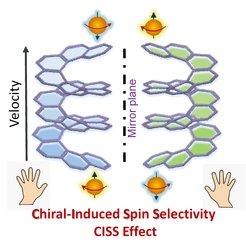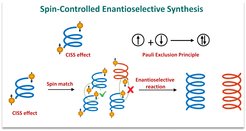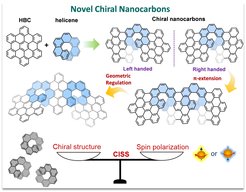Quantum Chiral Nanocarbons
Minerva Fast Track Group
The Minerva Fast Track Group "Quantum Chiral Nanocarbons" started in April 2024 is led by Dr. Wenhui Niu.

Chiral nanocarbons have emerging as transformative quantum materials for the next generation quantum applications due to their inherent chirality, intriguing optoelectronic properties, and in particular, their unique chiral-induced spin selectivity (CISS) effect. CISS effect describes the selective transmission of electrons’ spin over the chiral skeletons, which makes chiral molecules work as a spin filtering. In another word, during the electron transfer over chiral molecules with specific handedness, one spin direction is preferred to be transferred, while the other spin direction is blocked, enabling the generation of spin polarized currents. Based on this intriguing phenomenon, our group aims to establish unique research targets including CISS effect guided asymmetric organic synthesis, chiral structure construction as well as spintronics device fabrication, aiming to develop the single molecular level in-depth understanding of CISS effect; utilize it to promote the enantioselective synthesis of complicate chiral structures; and the apply next-generation chiraltronics, respectively.
Spin-controlled Enantioselective Synthesis

For chiral molecules, the electron spin is strongly coupled to the molecular frame. Therefore, electron transfer and electron rearrangement of chiral reactants (and intermediates) can be affected during the reaction based on CISS effect, which can be used to provide spin control over chemical reactions, therefore, enabling to control the reaction path and achieve enantioselective synthesis. Benefiting from this feature, one of our research interests is to apply CISS effect to design the novel chemical synthesis of chiral and helical carbon nanostructures based on spin orientation control during the reaction. The spin-control over the reaction will require low-temperature and strong magnetic field, potentially presenting significant advantages including high efficiency and high enantioselectivity, superior to those of traditional organic reaction. The related attempts may open a new avenue into spin-controlled chemistry, which may provide transformative synthetic strategies towards chiral molecules.
Versatile Chiral Nanocarbons Construction

Chiral nanocarbons featuring customized topology have been considered as promising candidates for understanding the intricate interplay between the chiral structure and spin polarization. Through exquisite structure design, a series of novel chiral nanocarbons will be developed with precise control over the number, structural arrangement and pi-extension of chiral centers, which will serve as molecular platforms to understand the origin of spin polarization down to single molecule level. The preparation of versatile chiral nanocarbons allows us to identify the key factors that affect spin polarizability, aiming to guide the design and synthesis of highly spin polarized chiral carbon nanostructures in the future. As a result, we will establish the design principles of chiral carbon nanostructures for next generation chiraltronics.
Chiral Spintronics Fabrication

Based on CISS effect, the construction of versatile chiral nanocarbons has attracted additional attention into the spin-dependent physical properties of this chiral matter and of chirality-related spintronic devices. The CISS effect allows the spin injection and transmission over organic chiral nanocarbons without the presence of a magnetic field or any ferromagnetic materials. As a result, we are enabling the control of overall electrical resistance of our organic chiral nanocarbons by applying magnetic field to affect the electron’s spin and spin polarized current. Utilizing these chiral structures with high spin polarizability, one highly interesting target is developing high-performance chiral spintronics with large spin polarized current and good spin current manipulation.



